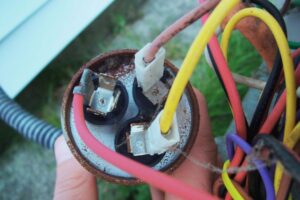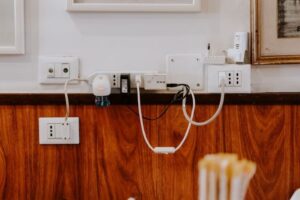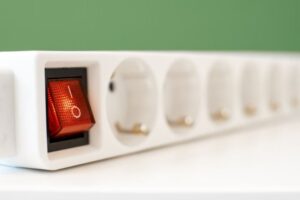Did you notice that the electric cords of almost all the electrical appliances that you connect to the electrical outlets in your home have two holes in them? Why do electrical plugs have holes in them?
Inside the electrical outlet, there are two contact wipers that the plugs slide into. These wipers have bumps on them. When you plug the electric cord into the outlet, its two holes catch the two bumps. The plugs or prongs are gripped more firmly in place by these two bumps. This improves the connection between the outlet and the plug.
In other words, the two bumps inside the electrical outlet use the two holes on the prong to hold it securely. Some electric plugs are heavy because of the size of the cord and the plug itself. This setup prevents heavy plugs and cords from quickly slipping out of the electrical socket.
Read on to learn more about why there are holes in electrical plugs and a short history of why electric prongs have holes in them.
Why Do Electrical Plugs Have Holes in Them?
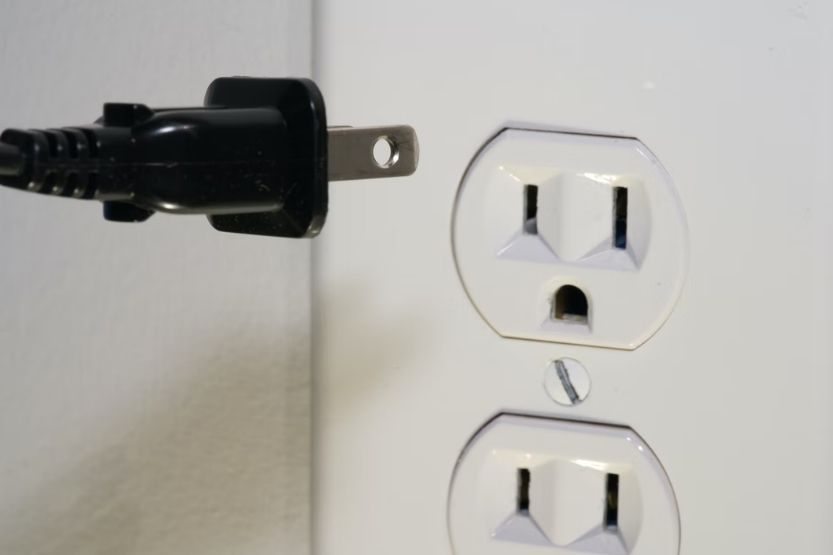
There are two contact wipers in most electrical outlets or sockets. These wipers have bumps on them. The moment you plug an electric cord into the outlet, the two holes in each prong will catch the bumps in the wipers of the socket.
Improves Contact Between the Prongs and Socket
So, the plugs are gripped more firmly in place by the two bumps inside the socket. It also improves the contact or connection between the prongs and the socket. There are electric cords with plugs that are heavy. So, the holes in the bumps prevent the cord from slipping quickly out of the electric outlet.
Electric Plugs Without Holes
There are also electric plugs without holes in them which are also safe to use. Prongs are available as Type A or Type B. Both types have two flat prongs with holes close to the tip, but not always. Some electrical sockets or outlets have two-spring action blades. They can hold the sides of the plugs preventing them from slipping out.
Suggested Electrical Outlet Heights for Different Areas of the House
What Are the Holes in Electrical Plugs For?
For the average person, it is bizarre to see two holes in the prongs of an electric cord. They are asking: why do electrical prongs have holes in them? They are there, so; there must be a reason for their being. My research on this topic has yielded the following results.
Here are the reasons for the two holes:
1. To Save on Raw Material
Perhaps this is not the primary reason, but it appears economical. Manufacturers of electric cords will save on raw material if they produce prongs with holes in them.
That hole in each prong will be a lot of metal saved if you consider the millions of electrical cords being manufactured and sold worldwide – every day. Out of every 20 holes that they punch from the prongs, manufacturers can gather enough metal to melt and produce one more prong. In other words, manufacturers’ get’ free metal out of every 20 prongs.
2. To Seal the Deal
Why do electrical plugs have holes in the prongs? Some manufacturers want to convey specific messages regarding their electronic devices to their customers. They usually put the message in a tag attached to a zip tie inserted through the holes. If you will severe that zip tie, you have acknowledged that you have read their terms and conditions.
The plastic tie serves as a small padlock that can run through one or both holes. Some construction companies require this sealing in their construction projects. You cannot plug the prongs without removing the zip tie.
Once you break this tie, they assume that you have already read the instructions, and the manufacturer is no longer responsible for what you do with it.
It is similar to what construction companies are doing to prevent burglaries in their construction sites. They implement a level of security that ensures burglars will be discouraged from breaking into their construction sites.
3. Provide a Firmer Grip and Improved Contact
The hole in each prong is an open space for the bump inside the socket to slide into. Inside a standard electrical socket, there are two wipes with a tiny bump in each of them. These round bumps fit snugly into the holes of the prongs.
In that way, a more secure and firm grip is achieved. It will also improve contact between the prong and the electrical socket. Another benefit is that the plug will not slip even if it is heavy.
What NEMA Says
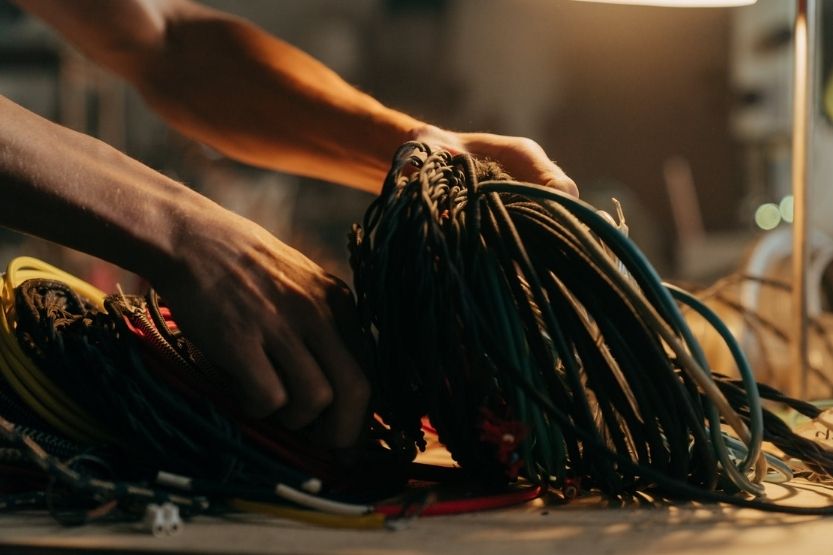
Manufacturers Must Follow NEMA’s Standards for Plugs’ Design
According to the National Electrical Manufacturers Association (NEMA), the holes in electrical prongs are there only for the convenience of the manufacturers. If manufacturers want to put those holes, they must be in the precise spots that NEMA has authorized. NEMA is the authority that sets the standards for the designs of electrical plugs.
Electrical Plugs’ Holes Are Optional
Here is their statement relating to these prong holes: “The hole in the flat blade is optional.” NEMA also said that these holes are just only there for manufacturing purposes. But if the manufacturer wants to put holes in their plugs, they must be located as per NEMA’s dimensions.
If you want more details, you can refer to the NEMA document, particularly page 17 of ANSI/NEMA WD 6-2002.
Again, why do electrical plugs have holes in them? The holes in the electrical plugs improve the connection between the outlet and plug. This is due to the plug’s bumps inside that catch the holes.
More Facts About Holes on Electrical Prongs
Now let’s discuss some relevant facts about holes on electrical prongs to determine their purposes and functions:
1. Holes Match the Bumps
The holes in the plugs match the bumps inside the socket contacts. This enhances the grip of the socket to the electric plug. It is a mechanical feature that they call ‘detent.’ These holes are present in un-grounded, two-prong, and three-prong grounded electric plugs.
2. Holes Are Optional
According to NEMA, the regulatory body that sets the standards in electric plug designs, the holes in the prongs are optional. They are there for the convenience of their manufacturers.
Even NEMA documents say they are a part of the locking or retention mechanism inside electric sockets that can hold the prongs in place. This fact is documented in two of NEMA’s publications, namely NEMA 5-15P Blade Holes and Power Plug & Outlet Types A & B – World Standards.
3. Convenience in Manufacturing
Some say that the prongs’ holes facilitate their installation of the plastic grips while they are being manufactured.
4. Force of Habit
The first electrical receptacles were not strong enough to secure the plugs during the early days. So, they built small nubs inside them, which could grip the prong holes when they are plugged in.
With further research and development, the engineered designs of electrical sockets improved and became better. They were brought to more current UL standards. Over time, it became unnecessary for prongs to have holes. However, they are still made this way because of habit.
5. Reduce Costs
The volume of the holes punched out from the blades of prongs becomes significant if you are producing millions of electric plugs – every day, around the world. Every little bit of metal coming from these holes can add considerable savings in material. Manufacturers will take advantage of that whenever possible.
6. Security
You can buy small padlocks with rounded bolts that go through the prong holes. That will prevent children from inserting the plug into an electric socket. However, this is only a recent adaptation of these prong holes.
7. Prong Holes Were Designed to Prevent Plugs from Falling Out
Harvey Hubbell is the person who invented the two holes on US electric plugs back in 1913. He designed it to prevent plugs from falling out of the electric outlet. Hubbell also patented this electric plug design in the United States.
8. Improve Strength
Some engineers believe that the hole enhances the overall strength of the plug. However, other engineers disagree with this assumption.
9. Plugs Without Holes Are Safe to Use
With or without holes, electric prongs are safe to use. There are two types of prongs – Type A and Type B. Both have flat plugs that have holes, although not always. Some sockets have two spring-action blades that can secure both sides of the prongs and prevent them slipping out.
In the United States and Canada, ungrounded Type A outlets are no longer allowed in new constructions. However, older buildings still have this type of outlet.
What Is the Current Situation Relating to Plugs with Holes?

Today, the holes on electric plugs do not serve consumers. If there are no holes in the prongs you are using, they will work fine. The design of modern sockets is entirely different from the old sockets that were used before.
Modern designs of electric sockets rely more on friction to prevent electric plugs from falling out. That’s why the holes are no longer needed. So, if there is no reason, why do electrical plugs have holes in the prongs? Holes are there in prongs simply because people expect them to be there.
Short History on Electrical Plugs
First Electrical Plug in the US
Harvey Hubell, an American inventor, patented the first electrical plug in the United States. Contrary to common assumption, his patented electrical plug has no holes in the blades. His blades featured semi-circular indents on both sides.
Dents Prevent the Plug from Falling Out
The semi-circular dents were designed to prevent the plug from falling out by hooking it to the electric socket. This design became iconic, and other inventors attempted to modify it to make one of their own.
Other Investors Produced Plugs With Round and Square Holes
So, other inventors produced plugs with round holes, while others had square holes on the blades. Hubell sued them for copyright infringement. Unfortunately, he lost his cases. However, this led the authorities to realize a need for a universal prong design.
So, the different designs converged into just one, resulting in electrical plugs with holes in the middle with semi-circular indents on the sides like Hubell’s plugs.
Conclusion: Why Do Electrical Plugs Have Holes in Them?
There are two contact wipers inside the electrical outlet, which the plugs slide into. These wipers have bumps in them. When you plug the electric cord into an outlet, the two bumps catch the holes of the plug.
So, the prongs or plugs are gripped more firmly in place by the two bumps because of the holes. This condition also improves the electrical connection between the outlet and the plug.
Read next:


